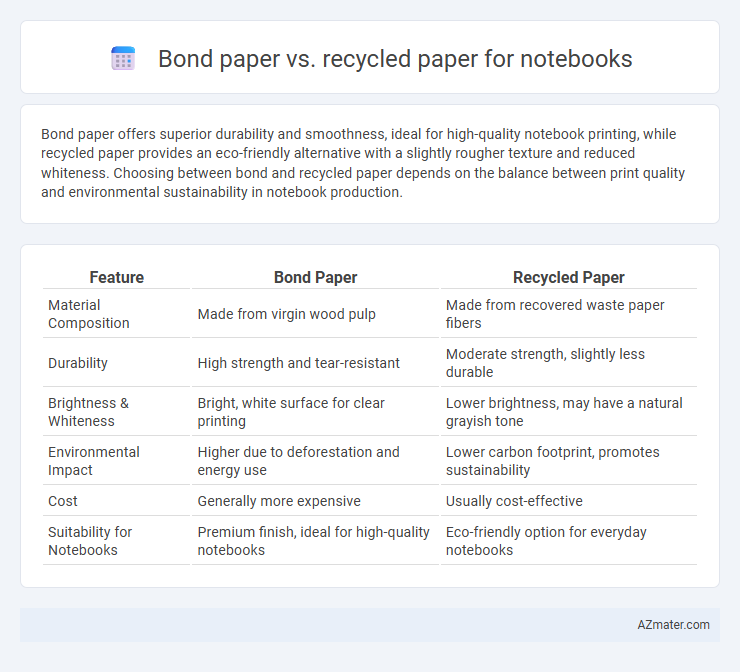Bond paper offers superior durability and smoothness, ideal for high-quality notebook printing, while recycled paper provides an eco-friendly alternative with a slightly rougher texture and reduced whiteness. Choosing between bond and recycled paper depends on the balance between print quality and environmental sustainability in notebook production.
Table of Comparison
| Feature | Bond Paper | Recycled Paper |
|---|---|---|
| Material Composition | Made from virgin wood pulp | Made from recovered waste paper fibers |
| Durability | High strength and tear-resistant | Moderate strength, slightly less durable |
| Brightness & Whiteness | Bright, white surface for clear printing | Lower brightness, may have a natural grayish tone |
| Environmental Impact | Higher due to deforestation and energy use | Lower carbon footprint, promotes sustainability |
| Cost | Generally more expensive | Usually cost-effective |
| Suitability for Notebooks | Premium finish, ideal for high-quality notebooks | Eco-friendly option for everyday notebooks |
Introduction to Bond Paper and Recycled Paper
Bond paper is a high-quality, durable writing material made primarily from cotton fibers, known for its strength and smooth texture, making it ideal for professional notebooks and archival use. Recycled paper is produced from reclaimed paper fibers, emphasizing environmental sustainability by reducing waste and conserving natural resources, often used in eco-friendly notebooks. Both papers serve distinct purposes, with bond paper offering premium feel and durability, while recycled paper appeals to eco-conscious consumers.
Material Composition: What Are They Made Of?
Bond paper is primarily made from high-quality wood pulp, often bleached to achieve a smooth, bright finish ideal for professional documents and notebooks. Recycled paper for notebooks incorporates post-consumer fibers, blending used paper materials with virgin pulp to reduce environmental impact while maintaining durability. The material composition differences affect texture, weight, and eco-friendliness, with bond paper favoring premium quality and recycled paper emphasizing sustainability.
Environmental Impact Comparison
Bond paper typically requires more energy and raw materials during production, leading to a higher carbon footprint compared to recycled paper. Recycled paper for notebooks reduces deforestation, conserves water, and decreases landfill waste by reusing fibers, making it a more sustainable choice. Choosing recycled paper supports circular economy principles and significantly lowers environmental impact throughout the paper lifecycle.
Paper Quality and Durability
Bond paper offers superior smoothness, brightness, and strength, making it ideal for high-quality notebook pages that resist tearing and smudging. Recycled paper prioritizes environmental benefits but often has a rougher texture and slightly lower durability due to fiber degradation during recycling. Notebooks made with bond paper maintain crisp writing and longevity, while those with recycled paper may show wear faster, though advancements in recycling technology are narrowing this gap.
Writing Experience: Texture and Ink Absorption
Bond paper offers a smooth texture that enhances pen glide and ensures crisp, clear lines, making it ideal for detailed writing and sketching. Recycled paper typically has a slightly rougher surface and varied fiber content, which can lead to uneven ink absorption and occasional smudging. Choosing bond paper for notebooks provides a more consistent and high-quality writing experience, especially for fountain pens or gel inks.
Cost Differences and Affordability
Bond paper typically costs more than recycled paper due to its higher quality and brightness, making it preferred for professional notebooks. Recycled paper offers a more affordable option, often priced 10-30% lower, appealing to budget-conscious consumers and eco-friendly brands. Choosing recycled paper can significantly reduce notebook production costs while supporting sustainable practices.
Availability and Sourcing
Bond paper is widely available through major office supply chains and paper manufacturers, ensuring consistent quality and easy sourcing for notebook production. Recycled paper, while increasingly accessible, depends on region-specific recycling programs and supply fluctuations, sometimes limiting availability for large-scale notebook manufacturing. Sourcing recycled paper supports sustainable practices but may require collaboration with specialized suppliers to secure consistent inventory.
Suitability for Different Types of Notebooks
Bond paper offers high opacity and smooth texture, making it ideal for professional notebooks, legal pads, and high-quality journals requiring crisp printing. Recycled paper, often slightly rougher and less bright, suits eco-friendly notebooks, school supplies, and casual notetaking where environmental impact is prioritized over premium finish. The choice depends on the notebook's purpose: bond paper enhances presentation and durability, while recycled paper supports sustainability with adequate functionality.
Pros and Cons: Bond Paper vs Recycled Paper
Bond paper offers superior brightness, smoothness, and durability, making it ideal for high-quality notebooks with crisp, clear printing; however, it is often more expensive and less environmentally friendly. Recycled paper supports sustainability by reducing waste and conserving resources but tends to have lower brightness, can be rougher in texture, and may cause ink to feather or bleed. Choosing between bond and recycled paper involves balancing print quality and tactile experience against ecological impact and cost.
Final Recommendation: Choosing the Right Paper for Notebooks
Bond paper offers durability and smooth texture ideal for professional notebooks, while recycled paper emphasizes sustainability and eco-friendliness with often slightly rougher texture. For notebooks intended for extensive writing or archival use, bond paper ensures longevity and clean print quality, whereas recycled paper suits environmentally conscious consumers prioritizing green practices. Balancing functionality with environmental impact depends on the notebook's purpose, making bond paper preferred for premium use and recycled paper for eco-friendly choices.

Infographic: Bond paper vs Recycled paper for Notebook
 azmater.com
azmater.com